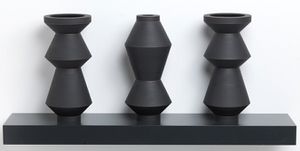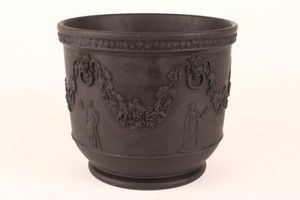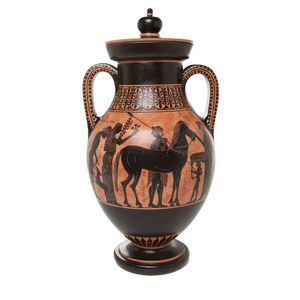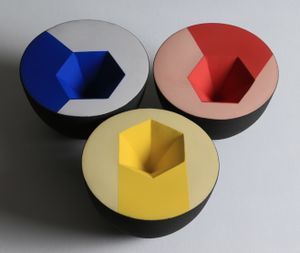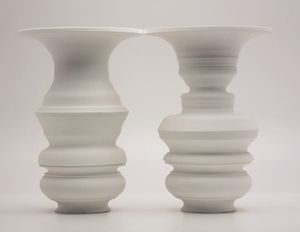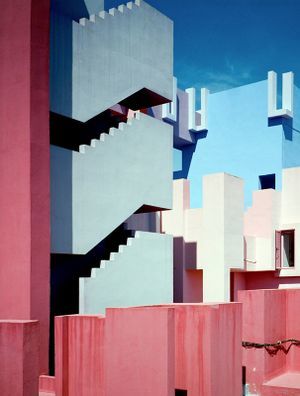Difference between revisions of "User:0960620"
| Line 25: | Line 25: | ||
[[File:Lamurallaroja.jpg|thumb|La Murulla Roja]] | [[File:Lamurallaroja.jpg|thumb|La Murulla Roja]] | ||
| + | |||
| + | This preliminary research into my artefact made me the most interested in three aspects of my form. First: negative space. In this Triptych, the white, reflective wall interacts as much with the black forms as much as the forms interact with each other. I think to make a 3D, tangible aspect of the shape of the white space between the forms would be an interesting way to explore the artefact. That, or bringing the white forms to life alongside black forms, so the two could truly interact physically. | ||
| + | |||
| + | The second aspect that interests me about the form is the fact that it is a deconstruction of domestic ceramic vessels- exmaple, the archetypal plate, bowl and vase. I think it would be interesting to create a tanigble way of letting the viewer understand this deconstruction. Perhaps by letting the viewer arrange, construct and deconstruct forms themselves from similiar shaped geometric pieces to the ones in Smith's work. | ||
=='''WORK'''== | =='''WORK'''== | ||
| − | |||
| − | |||
I started by lasercutting, as it is digital and craft. My aim was to make a 3D sculpture that further reduced the form of this artefact down and dissected it's form. Is a vase still a vase if it exists in 3D but cannot be filled, and exists on a 2D plane? I traced out the outline of the form and vectorised it so it would fit together as a 3D form. | I started by lasercutting, as it is digital and craft. My aim was to make a 3D sculpture that further reduced the form of this artefact down and dissected it's form. Is a vase still a vase if it exists in 3D but cannot be filled, and exists on a 2D plane? I traced out the outline of the form and vectorised it so it would fit together as a 3D form. | ||
| Line 34: | Line 36: | ||
However, the first time I did this, the "craft" side went wrong- the wood didn't fit perfectly. I decided I'd try again with this idea later with other forms, because making a 3D form 2D but still 3D interests me. | However, the first time I did this, the "craft" side went wrong- the wood didn't fit perfectly. I decided I'd try again with this idea later with other forms, because making a 3D form 2D but still 3D interests me. | ||
| − | |||
I also laser cut a 2D form of one of the vases, with the idea of further deconstructing the vases back into their original form (plate, vase, bowl). I coloured one half into a matt black. The idea was that the viewer could arrange the pieces, forever constructing or deconstructing whichever form they liked, making it a true, limitless deconstruction. I found, also, when I mixed the black/white sides together, it also created an interesting effect and more ways of arranging the pieces. | I also laser cut a 2D form of one of the vases, with the idea of further deconstructing the vases back into their original form (plate, vase, bowl). I coloured one half into a matt black. The idea was that the viewer could arrange the pieces, forever constructing or deconstructing whichever form they liked, making it a true, limitless deconstruction. I found, also, when I mixed the black/white sides together, it also created an interesting effect and more ways of arranging the pieces. | ||
| − | |||
| − | (Example of how the pieces would be deconstructed to make 2D forms representing different ceramic pieces | + | (Example of how the pieces would be deconstructed to make 2D forms representing different ceramic pieces) |
| + | |||
| + | |||
| + | The second aspect of my artefact that I wanted to initially explore was | ||
Revision as of 17:51, 3 May 2018
RESEARCH
I started off using this artifact as the beginning of my research. I was drawn to it's geometry, symmetry and the way that the matt, black objects interacted with the negative white space inbetween them, to not just make 3 forms but 5.
Further research led me to the fact that the ceramicist, Martin Smith, was heavily intereseted in architecture (hence the perfect geometry of his work) and new technology in ceramics. This particular piece, "Triptych in the form of Vase no. 1", is a deconstruction of the forms of the plate, the bowl and the vase; combining the seperate forms into three conglomerate sculptures, he explores how abstract he can make these parts.
The forms were also inspired by Wedgewood Black, a matt-black ceramic look popularised by the company Wedgewood, and vases from Greek antiquity, distinct in their terracotta with black glaze and their narrative style. These forms tell a new narrative. The hint of terracotta at the seams of the forms reminds the viewer these are not just sculptures, different though they are from the archetypal ceramic object, they are still inspired and grounded in ceramic history. These ideas gave me a lot to work with in terms of the context of my artifact.
My initial research into Martin Smith, his work, and my chosen artefact turned up lots of useful quotes:
- "the formal language of the vessel and the way that it can both contain a space and define a place”
- (Smith uses) "...elements of architectural language and uses ‘poetic geometry’"
- “abstractions of domestic wares”
- "Pots always reference architecture in defining space, containing, and making space useful; these small pieces have an strong architectural quality about them"
- "These new tripartite vases are improvisations and deconstructions of a number of vase types, built around a basic square grid and grouped in threes, consisting of a pair framing a single form. Although only three black ceramic objects are there in front of you, there could be seen to be two other more elusive ones, implied by the spaces in between them. These forms are tightly grouped on shelves at such a height that their top surfaces are just out of sight – they could from this viewpoint therefore be hollow perhaps, or solid."
To present my artefact to my peers, I referenced other pieces of ceramics I found that also referenced geometry and negative space, as examples of how these elements of the design could be explored in different ways.
I also referenced La Muralla Roja, a piece of architecture in Spain that is entirely geometric. The building is pink & blue, and the way these planes of colour and the negative space of the sky interact is interesting.
This preliminary research into my artefact made me the most interested in three aspects of my form. First: negative space. In this Triptych, the white, reflective wall interacts as much with the black forms as much as the forms interact with each other. I think to make a 3D, tangible aspect of the shape of the white space between the forms would be an interesting way to explore the artefact. That, or bringing the white forms to life alongside black forms, so the two could truly interact physically.
The second aspect that interests me about the form is the fact that it is a deconstruction of domestic ceramic vessels- exmaple, the archetypal plate, bowl and vase. I think it would be interesting to create a tanigble way of letting the viewer understand this deconstruction. Perhaps by letting the viewer arrange, construct and deconstruct forms themselves from similiar shaped geometric pieces to the ones in Smith's work.
WORK
I started by lasercutting, as it is digital and craft. My aim was to make a 3D sculpture that further reduced the form of this artefact down and dissected it's form. Is a vase still a vase if it exists in 3D but cannot be filled, and exists on a 2D plane? I traced out the outline of the form and vectorised it so it would fit together as a 3D form.
However, the first time I did this, the "craft" side went wrong- the wood didn't fit perfectly. I decided I'd try again with this idea later with other forms, because making a 3D form 2D but still 3D interests me.
I also laser cut a 2D form of one of the vases, with the idea of further deconstructing the vases back into their original form (plate, vase, bowl). I coloured one half into a matt black. The idea was that the viewer could arrange the pieces, forever constructing or deconstructing whichever form they liked, making it a true, limitless deconstruction. I found, also, when I mixed the black/white sides together, it also created an interesting effect and more ways of arranging the pieces.
(Example of how the pieces would be deconstructed to make 2D forms representing different ceramic pieces)
The second aspect of my artefact that I wanted to initially explore was
